Setting out and laying self adhesive flooring tiles
Setting up to lay vinyl tiles
For this you will need the calculations you used to calculate the number of tiles required on this other page.
- In the previous calculations, you determined the number of tiles required across the width of the room (0.9 + 10 + 0.9) - the important aspect is the number of full tiles (in this case 10).
- If the number of full tiles is an even number, establish the centre of both end (shortest) walls. Stretch a piece of string at floor level between the wall centres, secure the string at both ends by tying it around a heavy object (such as a brick).
- If the number of full tiles is odd, the line needs to be offset by half a tile width from the centre of the end walls.
- Now using the original calculations for the number of tiles required along the length of the room (0.7 + 12 +0.7), again the number of full tiles is important (12).
- If the number of full tiles is an even number, establish the centre of both side (longest) walls. Stretch a piece of string at floor level between the wall centres, secure the string at both ends by tying it around a heavy object (such as a brick).
- If the number of full tiles is odd, the line needs to be offset by half a tile width from the centre of the side walls.
- You've now established the starting point for laying the vinyl tiles.
Laying vinyl tiles
Thoroughly sweep or vacuum the sub-floor to remove all dust etc. You are now ready to start laying the tiles.
Always read and follow the guidelines/instructions provided by the tile manufacturers.
Get to know your tiles ! Generally there will be an arrow marked on the reverse, the tiles must be laid with the arrow running in the same direction (although the tiles are usually nominally square, there is often an inaccuracy which will not have an effect if all the tiles are laid with the arrow in the same direction).
Packets of self-adhesive Vinyl tiles should normally be opened and kept in warm conditions for 24 hours before laying.
Decide upon the direction that the arrow should point - it does not matter which direction is chosen providing you remember it and always use it. It is often useful to make a note of the direction in case you are interrupted while laying the floor - marking it on a piece of masking tape applied to the first tile you lay should be an adequate reminder.
Making a note of the direction of the arrow, peel off the backing from the first tile and CAREFULLY place it with a corner at your starting point.  Check that it is correctly positioned along the string lines, initially press it down gently, then working from the centre outwards apply firmer pressure all over - finally rub along each edge. Lay the second tile against a side of the first tile and aligned to one of the string lines, before firming it down ensure a close fit between the tiles but do not force them together and ensure that it is square and in line with the tile already laid.
Check that it is correctly positioned along the string lines, initially press it down gently, then working from the centre outwards apply firmer pressure all over - finally rub along each edge. Lay the second tile against a side of the first tile and aligned to one of the string lines, before firming it down ensure a close fit between the tiles but do not force them together and ensure that it is square and in line with the tile already laid.
Continue laying additional tiles (rembering to note the direction of the arrow before you remove each piece of backing paper).
Do not lay the tiles as a strip one tile wide, 'build' out from the first tile into a quarter of the room until all the full tiles are laid. Then repeat in an adjacent quarter, and then the final two quarters.
Tip: As you kneel on freshly laid tiles to continue the installation, place a piece of plywood on top of a cloth between yourself and the tile. This will spread your weight and reduce the possibility of individual tiles being damaged or slipping.
Cutting edge tiles
 To ensure an accurate fit at the walls, loose lay a single full tile exactly over the tile laid nearest the wall (making sure that the arrow is correctly aligned), then place another tile on top of it and up against the wall. Draw a line across the 'middle' tile where the top tile overlaps it. If one part will not have the arrow indication after cutting, mark the reverse with the arrow using a felt tip marker. Cut the tile (using a sharp knife and a steel straightedge) along the line. Before peeling off the backing paper, check that the cut tile actually fits. Remove the backing paper and fit it into position with the cut edge against the wall.
To ensure an accurate fit at the walls, loose lay a single full tile exactly over the tile laid nearest the wall (making sure that the arrow is correctly aligned), then place another tile on top of it and up against the wall. Draw a line across the 'middle' tile where the top tile overlaps it. If one part will not have the arrow indication after cutting, mark the reverse with the arrow using a felt tip marker. Cut the tile (using a sharp knife and a steel straightedge) along the line. Before peeling off the backing paper, check that the cut tile actually fits. Remove the backing paper and fit it into position with the cut edge against the wall.
For corners, use the above technique twice, once on each side of the corner. Cut the tile away from the corner to avoid over cutting into the area to be laid.
To fit around irregular shapes (such as doorways, mouldings or pipes etc.), make a cardboard or paper template to exact size and use this to draw the outline on a tile. Cut the tile to shape, before peeling off the backing paper, check that the tile fits (it should fit snugly but should not need to be forced into place).
When you have finished laying all the tiles, go over the floor once again to check that all tiles are firmly stuck down, pay particular attention to the edges.
After installation of a new vinyl tile floor, clean the surface with a suitable cleaner and then apply 2 coats of a suitable emulsion protective finish (check the manufacturers instructions).
Do not wet the floor for 5 to 7 days.
After care of vinyl tiles
Never use excessive amounts of water when cleaning vinyl tiles.
Sweep the floor regularly to remove surface grit and dust. Wipe over with a damp cloth or mop. When necessary a mild detergent can be added to the water. DO NOT use abrasive cleaners.
Stiletto heels and other sharp objects can damage vinyl floor so try to avoid.
Furniture left in the same position for any length of time will produce depressions in the floor covering, using protective pads under the furniture will reduce the damage.
Floor preparation - Planning - Calculate the number of tiles
